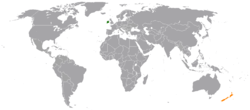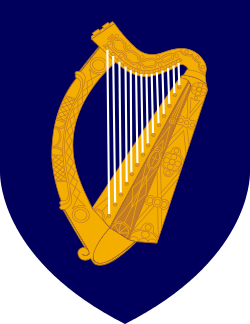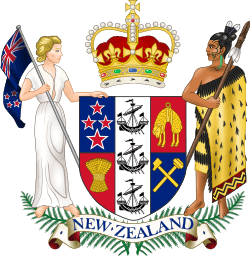Ireland–New Zealand relations
 |
|
Ireland |
New Zealand |
|---|---|
Ireland–New Zealand relations refers to the diplomatic relations between Ireland and New Zealand. Both nations are English speaking nations. As a result of famine and poverty, several thousand Irish people migrated to New Zealand where today approximately 18% of the population can claim Irish heritage.[1] Both nations are members of the Australia Group, Organisation for Economic Co-operation and Development and the United Nations.
History

Historically, both Ireland and New Zealand were joined as one when the United Kingdom formally established the Colony of New South Wales in 1788 which included most of present day New Zealand. In 1840, New Zealand formally joined the British Empire after the signing of the Treaty of Waitangi.[2] The first major contact between both nations was during first wave of Irish immigration to New Zealand. Because the Irish were considered to be "British", it is unknown who the first Irish were to reach New Zealand, however, the first Irish migrants to reach New Zealand would have occurred around 1840 when the New Zealand Company first began assisting would-be migrants to settle in New Zealand.[3] In comparison to Irish immigration to North America and Australia, very few Irish people migrated to New Zealand, mainly due to the cost of travel and the enormous distance between both nations.[4] Over the years, however, several waves of Irish people would migrate to New Zealand and as a result, approximately 18% of the population of New Zealand today can claim Irish descent.[1]
Both Irish and New Zealand soldiers fought side-by-side for the British Empire during the Second Boer War from 1899–1902 and World War I from 1914–1918, especially during the Gallipoli Campaign.[5][6] During the Easter Rising in 1916 and when Ireland declared its independence from the United Kingdom in 1919, many Irish-New Zealanders became involved in the Irish cause, however, their numbers were never great which may have been attributed to the fact that most of those with Irish origins in the country were already second generation New Zealanders with loose connections with Ireland.[4] By 1947, New Zealand essentially became an independent nation after accepting the Statue of Westminster Adopting Act.
Post-independence
In April 1948, former Irish Taoiseach Éamon de Valera traveled to New Zealand seeking support for a united Ireland. However, de Valera was not successful due to the fact that Ireland remained neutral during World War II whereas New Zealand fought under the Commonwealth in the war.[7] Although New Zealand did not support a united Ireland, many in the nation still hold Ireland as an important contributor to their nation both culturally and historically.
In 1976, Ireland opened an honorary consulate-general in Auckland to represent Irish interests in the nation.[8] In 2000, New Zealand re-opened an honorary consulate-general in Dublin.[9] Both nations maintain strong political links and similar interests with regards to climate change and peaceful resolutions in trouble zones throughout the world. Several prime ministers have visited each other's nations, respectively. Furthermore, three of the Prime Minister of New Zealand have been born in Ireland.[10] Both nations have established working holiday visa with each other and work closely together with regards to agriculture.[11]
State visits
Presidential and Prime Ministerial (Taoiseach) visits from Ireland to New Zealand[12][13][1]
- Taoiseach Charles Haughey (1988)
- President Mary McAleese (1998, 2007)
Prime Ministerial visits from New Zealand to Ireland[14][15]
- Prime Minister Bill Rowling (1975)
- Prime Minister Helen Clark (2005)
Trade
In 2015, Ireland exported $222 million USD worth of exports to New Zealand, mainly crude oil. At the same time, New Zealand exports to Ireland amounted to $52 million USD. New Zealand's exports are primarily butter and other dairy and frozen fish.[16]
Resident diplomatic missions
- Ireland is accredited to New Zealand from its embassy in Canberra, Australia and maintains an honorary consulate-general in Auckland.[17][18]
- New Zealand is accredited to Ireland from its High Commission in London, United Kingdom and maintains an honorary consulate-general in Dublin.[19]
See also
References
- 1 2 3 State Luncheon for President of Ireland, Mary McAleese
- ↑ Closer relations with New Zealand
- ↑ British & Irish immigration, 1840-1914
- 1 2 Irish Immigration to New Zealand
- ↑ New Zealand at War
- ↑ Bureau of Military History
- ↑ A Policy of Futility: Eamon de Valera’s Anti-Partition Campaign, 1948-1951
- ↑ Honorary Consulate-General of Ireland in Auckland, New Zealand
- ↑ New Zealand appoints envoy
- ↑ New Zealand Prime Ministers
- ↑ Ireland and New Zealand agriculture: trade and climate change
- ↑ [https://www.beehive.govt.nz/release/visit-president-ireland Beehive: Visit of The President of Ireland
- ↑ PM Transcripts: Charles Haughey in New Zealand
- ↑ New Zealand Prime Minister's visit
- ↑ Beehive: New Zealand and Ireland discuss film agreement
- ↑ New Zealand Ministry of Foreign Affairs and Trade: Ireland
- ↑ Embassy of Ireland, Canberra
- ↑ Honorary Consulate-General of Ireland in Auckland
- ↑ New Zealand High Commission, London

